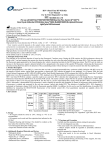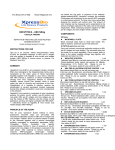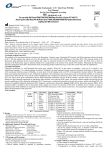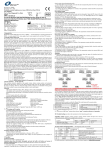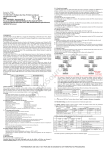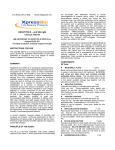Download HBV Quantitative Real Time PCR Kit User Manual For In
Transcript
Issue Date: Jul 1st, 2012 Revision No.: ZJ0007 HBV Quantitative Real Time PCR Kit User Manual For In Vitro Diagnostic Use Only HD-0002-02-A+B For use with ABI Prism®7000/7300/7500/7900/Step One Plus; iCycler iQ™4/iQ™5; Smart Cycler II;Bio-Rad CFX 96;Rotor Gene™6000; Mx3000P/3005P;MJ-Option2/Chromo4; LightCycler®480 Instrument Shanghai ZJ Bio-Tech Co., Ltd. www.liferiver.com.cn Tel: +86-21-34680596 [email protected] Fax: +86-21-34680595 2nd floor,No.15 Building,No.188 Xinjunhuan road, PuJiang Hi-tech Park Shanghai China 1. Intended Use HBV quantitative real time PCR kit is used for the detection of HBV in serum or plasma by using real time PCR systems. Its characteristics: High sensitivity: lower detection line 500 IU/ml;LOQ:103 ~108 IU/ml (Note: Analysis sensitivity depends on the sample volume, elution volume, nucleic acid extraction methods and other factors .If you use the DNA extraction buffer in the kit, the analysis sensitivity is the same as it declares. However, when the sample volume is dozens or even hundreds of times greater than elution volume by some concentrating method, it can be much higher.) High specificity: test result will be positive, only to hepatitis B virus. Short operating time: One and a half hours totally Good stability: kept for 12 months at –20℃; CV≤5%; 2. Principle of Real-Time PCR The principle of the real-time detection is based on the fluorogenic 5’nuclease assay. During the PCR reaction, the DNA polymerase cleaves the probe at the 5’ end and separates the reporter dye from the quencher dye only when the probe hybridizes to the target DNA. This cleavage results in the fluorescent signal generated by the cleaved reporter dye, which is monitored real-time by the PCR detection system. The PCR cycle at which an increase in the fluorescence signal is detected initially (Ct) is proportional to the amount of the specific PCR product. Monitoring the fluorescence intensities during Real Time allows the detection of the accumulating product without having to re-open the reaction tube after the amplification. 3. Product Description Chronic hepatitis B virus (HBV) infection affects over 350 million people worldwide and over 1 million die annually of HBV-related chronic liver disease. Although many individuals eventually achieve a state of nonreplicative infection, the prolonged immunologic response to infection may lead to the development of cirrhosis, liver failure, or hepatocellular carcinoma (HCC) in up to 40% of patients. HBV is an enveloped virus in the family Hepadnaviridae, with partially double-stranded DNA and 42nm in diameter. Its antigenic components includes hepatitis B surface antigen (HBsAg), hepatitis B core antigen (HBcAg), and hepatitis B e antigen (HBeAg). Virus replicates in liver and sheds into blood in high concentration. HBV is transmitted through blood and body fluid. HBV real time PCR kit contains a specific ready-to-use system for HBV detection (for genotype A~H) through polymerase chain reaction (PCR) in the real-time PCR system. The master contains reagents and enzymes for the specific HBV DNA amplification. Fluorescence is emitted and measured by the real time systems´ optical unit during PCR. The detection of amplified HBV DNA fragment is performed in fluorimeter channel FAM with the fluorescent quencher BHQ1. DNA extraction buffer is available in the kit. In addition, the kit contains a system to identify possible PCR inhibition by measuring the HEX/VIC/JOE fluorescence of the internal control (IC). Four quantitation standards are supplied, allows the determination of the gene load. 4. Kit Contents Ref. Cap Color Type of reagent Presentation 25rxns 1 Blue DNA Extraction Buffer 1 vial, 1.8ml PCR Gray HBV Reaction Mix 1 vial, 950μl System 2 3 Blue PCR Enzyme Mix 1 vial, 12μl 4 Yellow Molecular Grade Water 1 vial, 400μl 5 Orange Internal control (IC) 1 vial, 30μl Pink HBV QS1 (5×107IU/ml) 1 vial, 20μl QS ★ 6 HBV QS2 (5×106IU/ml) 1 vial, 20μl Purple System 7 HBV QS3 (5×105IU/ml) 1 vial, 20μl 8 Orange HBV QS4 (5×104IU/ml) 1 vial, 20μl 9 Yellow ★QS:Quantitation Standard • For in vitro diagnostic use only. • This assay needs to be carried out by skilled personnel. 5. Storage • All reagents should be stored at -20°C. Storage at +4°C is not recommended. • Clinical samples should be regarded as potentially infectious • All reagents can be used until the expiration date indicated on the kit label. materials and • Repeated thawing and freezing (> 3x) should be avoided, as this may reduce the should be prepared in a laminar flow hood. sensitivity of the assay. • This assay needs to be run according to Good Laboratory Practice. • Cool all reagents during the working steps. • Do not use the kit after its expiration date. • Reaction mix should be stored in the dark. • Avoid repeated thawing and freezing of the reagents, this may 6. Additionally Required Materials and Devices • Biological cabinet • Real time PCR system reduce the sensitivity of the test. • Real time PCR reaction tubes/plates • Vortex mixer • Once the reagents have been thawed, vortex and centrifuge briefly • Pipets (0.5 μl – 1000 μl) • Cryo-container the tubes before use. • Disposable gloves, powderless • Sterile microtubes • Prepare quickly the Reaction mix on ice or in the cooling block. • Biohazard waste container • Refrigerator and freezer • Set up two separate working areas: 1) Isolation of the RNA/ DNA • Sterile filter tips for micro pipets • Tube racks and 2) Amplification/ detection of amplification products. • Desktop microcentrifuge for “eppendorf” type tubes (RCF max. • Pipets, vials and other working materials should not circulate 16,000 x g) among working units. • Use always sterile pipette tips with filters. 7. Warnings and Precaution • Wear separate coats and gloves in each area. Carefully read this instruction before starting the procedure. • Avoid aerosols 8. Sample Collection, Storage and transport • Collect samples in sterile tubes; • Specimens can be extracted immediately or frozen at -20°C to -80°C. • Transportation of clinical specimens must comply with local regulations for the transport of etiologic agents 9. Procedure 9.1 DNA-Extraction DNA extraction buffer is supplied in the kit, please thaw the buffer thoroughly and spin down briefly in the centrifuge before use. It’s better to use commercial kits for nucleic acid extraction. 1) Take 50ul serum or plasma, add 50μl DNA extraction buffer, and close the tube then vortex for 10 seconds. Spin down briefly in a table centrifuge. 2) Incubate the tube for 10 minutes at 100°C. 3) Centrifuge the tube at 13000rpm for 10 minutes. The supernatant contains the DNA extracted and can be used for PCR template. Attention: A. During the incubation, make sure the tube is not open, for the vapor will volatilize into the air and may cause contamination in case the sample is positive. B. The extraction sample should be used in 3 hours or stored at -20°C for one month. C. DNA extraction kits are available from various manufacturers. You may use your own extraction systems or the commercial kit based on the yield. For DNA extraction, please comply with manufacturer’s instructions. 9.2 Internal Control It is necessary to add internal control (IC) in the reaction mix. Internal control (IC) allows the user to determine and control the possibility of PCR inhibition. 9.3 PCR Protocol The Master Mix volume for each reaction should be pipetted as follows: OR ※PCR system without HEX/VIC/JOE channel may be treated with 1μl Molecular Grade Water instead of 1μl IC. 1) The volumes of Reaction Mix and Enzyme Mix per reaction multiply with the number of samples, which includes the number of controls, standards, and sample prepared. Molecular Grade Water is used as the negative control. For reasons of unprecise pipetting, always add an extra virtual sample. Mix completely then spin down briefly in a centrifuge. 2) Pipet 36μl (22.5μl for Smart Cycler II) Master Mix with micropipets of sterile filter tips to each Real time PCR reaction plate/tubes. Separately add 4μl (2.5μl for Smart Cycler II) DNA sample, QS1,QS2,QS3,QS4 and negative control to different reaction plate/tubes. Immediately close the plate/tubes to avoid contamination. 3) Spin down briefly in order to collect the Master Mix in the bottom of the reaction tubes. 4) Perform the following protocol in the instrument: 37°C for 2 min,1 cycle;94°C for 2 min,1 cycle;93°C for 15 sec,60°C for 60 sec,40 cycles. Fluorescence is measured at 60°C;FAM and HEX/VIC/JOE channels should be chosen. If you use ABI Prism® system, please choose “none” as passive reference and quencher. 5) 10.Threshold setting: just above the maximum level of molecular grade water. 11.Calibration for quantitative detection: Input each concentration of standard controls at the end of run, and a standard curve will be automatically formed. 12.Quality control: Channel Ct value Control FAM (Target Nucleic Acid) HEX/VIC/JOE (IC) Molecular Grade Water UNDET 25~35 QS1/QS2/QS3/QS4 ≤38,and Correlation coefficient of QS curve≤-0.98 —— 13. Data Analysis and Interpretation The following results are possible: 1) The Ct value in channel FAM shows ≤38. The result is positive: The sample contains HBV DNA. Quantitative value of samples is automatically reported according to the standard curve. Quantitative Value Data Analysis and Suggestion < 5×102IU/ml HBV DNA Positive; its concentration lower than 5×102IU/ml 2 3 HBV DNA Positive; the quantitative value for recommendation only 5×10 ~10 IU/ml HBV DNA Positive; the quantitative value is valid 103~108 IU/ml >108 IU/ml 1)HBV DNA Positive but the quantitative value for recommendation only 2)Re-test the sample after dilute the sample by several times, making the quantitative value within 103~108 IU/ml 2) The Ct value in channel FAM shows 38~40, please repeat again. If the result still shows 38~40,it can be considered negative. 3) In channel FAM no signal is detected, at the same time, a HEX/VIC/JOE signal from the Internal Control appears. The sample does not contain any HBV DNA. It can be considered negative. 4) Neither in channel FAM nor in channel HEX/VIC/JOE signal is detected. A diagnostic statement can not be made. Inhibition of the PCR reaction. For further questions or problems,please contact our technical support at [email protected]


